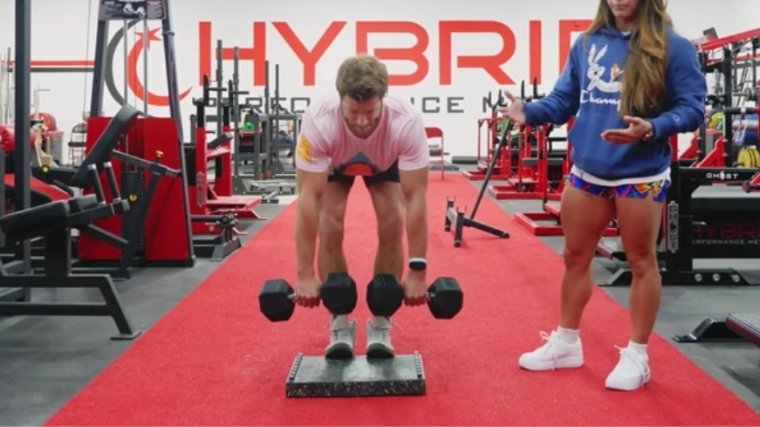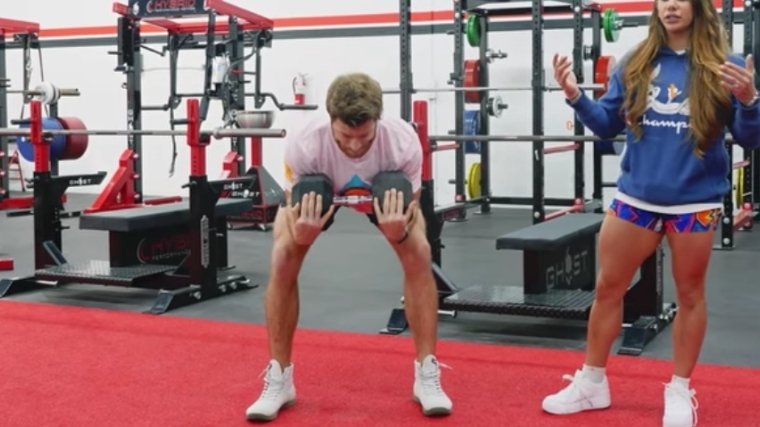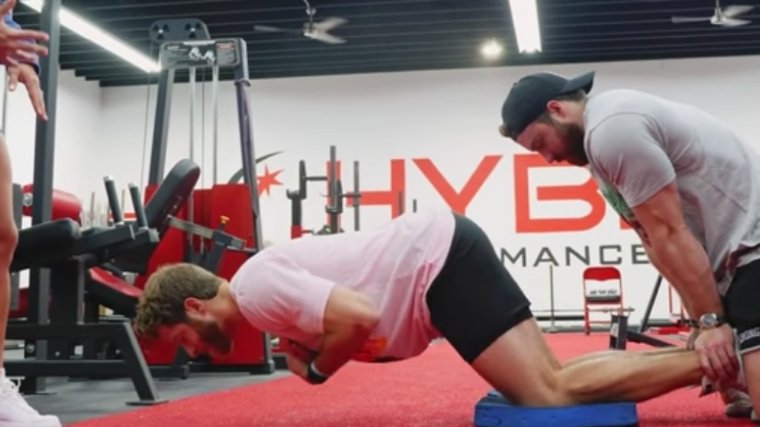Learn the 15 Best Hamstring Exercises for Power, Muscle, and Health
If you have weak hamstrings, then there’s a strong chance you’re not maxing out on your strength potential for squats and deadlifts. Plus, lack of hamstring eccentric strength is a known cause of hamstrings strains. Paying attention to them is great for performance, aesthetics, and injury prevention.
Since the hamstrings are extensors at the hip and flexors at the knees, they play an important role in your performance, so it pays to train both ways. With some help from multi-powerlifting world record holder Dr. Stefi Cohen, we break down the best hamstring exercises below for performance, strength, and hypertrophy.
Best Hamstring Exercises
- Lying Leg Curl
- Hamstring Slide
- Toes-Elevated Dumbbell RDL
- Dumbbell Good Morning
- Razor Curl
- Single-Leg Stability Ball Curl
- Nordic Hamstring Curl
- Eccentric Hip Extension Hamstring Curl With Sliders
- Kettlebell Swing
- Glute-Hamstring Raise
- Barbell Good Morning
- Romanian Deadlift
- Single-Leg Deadlift Romanian Deadlift
- Cable Pull-Through
- Banded Hamstring Curl
Editor’s note: The content on BarBend is meant to be informative in nature, but it shouldn’t take the place of advice and/or supervision from a medical professional. The opinions and articles on this site are not intended for use as diagnosis, prevention, and/or treatment of health problems. Speak with your physician if you have any concerns.
Hamstring Exercises Video
In the video below, former BarBend Editor Jake Boly demonstrates five of the following moves as Cohen walks you through how and why to do them.
[Related: Everything You Need to Know to Build Your First Workout Program]
Lying Leg Curl
The lying leg curl is underappreciated, and it’s often done with poor form. But when performed correctly and with a full range of motion, this exercise strengthens your hamstring and calf muscles. Make sure your upper body and hips are locked in, and the movement only comes from your hamstrings, which is the key to making this exercise more effective.
[Related: What You Need to Know About How to Increase Strength]
Benefits of the Lying Leg Curl
- The lying leg curl isolates and strengthens the hamstrings as knee flexors.
- It helps improve hamstring flexibility when used with a full ROM.
- Trains the calf muscles.
How to Do the Lying Leg Curl
Lie down on the leg curl machine with the back of your ankles underneath the pad and place the hips down onto the pad. Draw the belly button inwards to avoid movement compensations. Curl the weight towards your glutes quickly and then slowly lower on the eccentric, then pause at the bottom and repeat.
Hamstring Slide
The Hamstring slide trains your hamstrings as a knee flexor and a hip extender, strengthening your hamstrings in two ways. This exercise is easier than the razor curl (see below). It is a good exercise to start with when you’re looking to improve your eccentric hamstring strength — which, again, is the type of strength you want to focus on to prevent hamstring strains (since the lengthened position is where your hamstrings are weakest). Another benefit is that it requires no weight to load the muscle, so it’s joint-friendly.
[Related: Best Pre-Workout Supplements for Strength, Cardio, and More]
Benefits of Hamstrings Slides
- Increases eccentric hamstring strength to help prevent hamstring strains and improve squat and deadlift performance.
- Easier exercise to do than the razor and Nordic curl.
How to Do Hamstring Slides
Lie down on your back with your legs bent at 90 degrees and your heels underneath your knees. The heels should be on a pair of workout sliders. (If you’re doing this at home, you can place your heels on a pair of socks on a hardwood floor.) Squeeze your glutes to raise your hips and lower your heels away from your body until your legs are almost fully extended. Then flex your hamstrings to bring your heels back underneath your knees and repeat.
Toes-Elevated Dumbbell Romanian deadlift
RDL’s are a great accessory exercise for deadlifts and add strength and mass to your glutes and hamstrings. The toes-elevated variation takes this to a new level. Elevating the toes shifts the weight back on your heels, further isolating and strengthening your hamstrings. And when performed with a slow eccentric, it’ll help reinforce strength in a lengthened position to ward off unwanted strains.
[Related: The 8 Best Barbell Exercises for Mass, Strength, and Power]
Benefits of the Toes-Elevated Dumbbell RDL
- The elevated heels further isolate the glutes and hamstrings for more muscle-building and strength potential.
- Increases hamstring eccentric strength to help prevent hamstring strains.
How to Do the Toes Elevated Dumbbell RDL
Find a 25-pound bumper plate or low platform to elevate the toes and bring the feet close together. As you hinge, reach the dumbbells out so they’re tracking over the toes instead of keeping them close to the body. Control the eccentric tempo to feel the stretch properly, pause for a second in the bottom position, and hinge back up.
Dumbbell Good Morning
The barbell good morning is a great exercise to load the hamstrings, but not everyone has the shoulder mobility to reach behind them to stabilize the barbell. Or, after all the compressive/shear load on the spine from squatting and deadlifting, your spine needs a break. Enter the dumbbell good morning, which engages the anterior core, trains the same muscles as the barbell version but without the load on your spine. Having the weight anteriorly makes you more aware of upper body positioning too.
[Related: The Ultimate Guide On How to Choose a Barbell]
Benefits of the Dumbbell Good Morning
- Positioning of the dumbbell engages the anterior core and is easier on the lower back and shoulders than the barbell variation.
- Strengthens the lower back, hamstrings, and glutes at the same time.
How to Do the Dumbbell Good Morning
Hold a heavy dumbbell against your chest, keeping your shoulders down and chest up. Maintaining a soft bend in your knees, hinge at your hips until your torso is almost parallel to the ground, keeping your back in neutral. Pause for a second and return to the starting position, and repeat.
Razor Curl
The razor curl is a slight twist on the nordic curl that has you maintain flex hips. Flexing the hip allows for a more intense contraction of the hamstring at the hip and a more forceful contraction of the hamstrings at the knee. Plus, it’s been shown to decrease the susceptibility of anterior cruciate ligament injury. But be warned, this exercise is advanced and should be performed when you have built up your eccentric hamstring strength. (1)
[Related: The Best Kettlebells for Beginners, CrossFit, and Cardio]
Benefits of the Razor Curl
- Improves the eccentric strength of the hamstrings and increases glute strength
- Increases core strength due to falling forward with control.
How to Do the Razor Curl
Have a training partner hold your feet or use a barbell/piece of equipment to anchor your lower body. Slight flex your hips and hold this position for the entire exercise. Fall forward while controlling the eccentric and lightly touch the ground. Use your hands to assist on the concentric if you’re starting to help make it easier.
Single-Leg Stability Ball Curl
The single-leg hip extension hamstring curl strengthens the hamstrings both as hip extensors and knee flexors. And because of the unstable surface of the stability ball, the stabilization demands increase too, making your muscles work harder and making you more aware of your technique. When you emphasize the eccentric with this exercise, you’ll go a long way to bulletproofing your hamstrings. (2)
[Related: Build Muscle Anywhere With the Best At-Home Bodyweight Workouts]
Benefits of the Single-Leg Stability Ball Curl
- Strengthens the hamstrings, hip extensors, and knee flexors.
- The increased stabilization demands improve hip and core stability
- A great exercise for runners as the stability ball mimics the unevenness of road running.
How to Do the Single-Leg Single-Leg Stability Ball Curl
Lay on your back, place both feet on a stability ball with one leg bent, and engage your glutes. Raise your hips and lift one leg off of the ball. Now, curl the ball toward your butt with the working leg. Slowly reverse the movements and lower your hips to the floor, and repeat.
Nordic Hamstring Curl
Similar to the Razor curl and a little easier to do — but not by much — the Nordic hamstring curl is the real deal. The eccentric strength of your hamstrings is the only thing stopping you from crashing face-first on the floor.
This hamstring exercise has been shown to decrease the risk of hamstring injuries by 51 percent compared with those who didn’t do it. (3) That’s a hefty improvement, especially if your hamstrings are prone to strains.
Benefits of the Nordic Hamstring Curl
- This move might help reduce your risk of hamstring strains.
- The Nordic hamstring curl is a fantastic exercise for improving hamstring hypertrophy.
- You’ll improve your mental focus, because you’ll need a lot of it to safely execute this lift.
How to Do the Nordic Hamstring Curl
Kneel on both knees. Secure your ankles with equipment or have a partner hold them for you. Engage your hamstrings, glutes, and abs. Keep your back neutral. Slowly lean forward, using only your hamstrings until you catch yourself with your hands or gently reach the ground. Push yourself back up. Repeat.
Eccentric Hip Extension Hamstring Curl With Sliders
The eccentric hip extension hamstring curl with sliders trains your hamstrings as a knee flexor and a hip extender. This strengthens your hamstrings in two ways — double the gains, double the fun.
There is no concentric contraction with this variation, which means you’re focusing exclusively on the lengthening of your hamstrings. That’s crucial for deadlifting strength and control. It also means that this exercise is a great starting point when you’re looking to improve your eccentric hamstring strength.
Benefits of the Eccentric Hip Extension Hamstring Curl With Sliders
- You’ll improve the eccentric strength of your hamstrings, which is key for controlling your deadlifts.
- This move strengthens your hamstrings as both a knee flexor and hip extender.
- It’s a great variation of the Nordic hamstring curl that many people may find more accessible.
How to Do the Eccentric Hip Extension Hamstring Curl With Sliders
Lie down on your back. Keep a neutral spine. Bend your knees. Place sliders underneath your heels. Point your toes toward the ceiling. Squeeze your glutes to raise your hips. With control, slowly press your heels down and out. Straighten your legs until they’re on the ground. Slide your heels back. Repeat.
Kettlebell Swing
Kettlebell swings target your glutes and hamstrings for improved strength, power, and endurance. Plus, swinging a kettlebell trains stability and stabilizer muscles across your entire body. That’s because you’re constantly adjusting to the shifting center of mass with each repetition.
Kettlebell swings train your hamstrings to be powerful hip extensors — which you definitely need for a strong deadlift lockout. Speaking of deadlifts, kettlebell swings also help develop some serious grip strength, which you’ll need to support all that lockout strength.
Benefits of the Kettlebell Swing
- Kettlebell swings train your hamstrings for power, strength, and endurance.
- This move helps improve hip extension strength and power, which can help improve your deadlift lockout.
- You’ll get the added benefits of improved cardiovascular endurance and grip strength.
How to Do the Kettlebell Swing
Stand with your feet wider than shoulder-width apart. Place the kettlebell just in front of you. Hinge down to grip the kettlebell. Squeeze your armpits. Raise your chest. Hike the kettlebell behind you. Thrust your hips forward. Use this momentum to swing the kettlebell. Finish by squeezing your glutes and quads as the kettlebell reaches chest height. Repeat in a continuous loop for reps.
Glute-Hamstring Raise
The glute-hamstring raise (GHR) develops eccentric strength in your hamstrings and builds killer hamstrings and glutes. The lower back, hamstrings, and glutes are working together as a unit which is often the case for a lot of exercises that involve the hamstrings.
The GHR is a great exercise that can be performed for higher reps with body weight to increase glute, hamstring, and lower back hypertrophy.
Benefits of the Glute-Hamstring Raise
- Develops eccentric strength in your hamstring to help prevent hamstring strains.
- Extended time under tension for glutes, hamstrings, and lower back to help build strength and endurance.
- Can be progressed by adding load when bodyweight is mastered.
How to Do the Glute-Hamstring Raise
Adjust the GHR so your feet are secured, and your quads are resting on the middle of the pad, making sure you have enough space to lower your torso. Your knees are bent at 90 degrees and your body is straight. Then push your toes into the pad and extend your knees. With your arms folded across your body slowly lower your torso forward until you are horizontal. Return to the starting position by contracting your hamstrings. Reset and repeat.
Barbell Good Morning
The barbell good morning trains your lower back, glutes, and hamstrings as a unit. You’ll put your glutes and hamstrings through a large range of motion for better muscle-building potential while increasing your posterior strength.
This move requires a lot of shoulder mobility to keep the bar in place. If that’s an issue for you, feel free to switch it up to dumbbell good mornings.
Benefits of the Barbell Good Morning
- This move promotes glute strength and hypertrophy.
- You’ll engage your entire posterior chain and all the spinal stabilizers that help prevent spinal flexion.
- You can load this move heavier the dumbbell good morning variation.
How to Do the Barbell Good Morning
Set up a loaded barbell in a power rack. Position and unrack the bar as though you were going to perform a back squat. Walk the bar out. With a slight bend in your knees, hinge at your hips. Keep your chest up and shoulders down. Hinge until your torso is almost parallel to the floor. Contract your glutes and hamstrings to bring you back to standing. Reset and repeat.
Romanian Deadlift
The Romanian deadlift (RDL) is a close cousin of the standard deadlift. But instead of going all the way to the floor between reps, RDLs will have you stop the bar at mid-shin level. This tweak keeps constant tension on your hamstring and glute muscles. That tension makes RDLs a better option for adding mass to these muscles.
The RDL may be less stressful on your body than a conventional deadlift, as it doesn’t allow you to use as much weight. Still, you can take advantage of using a lighter weight to maximize hypertrophy.
Benefits Of The Romanian Deadlift
- This move provides constant tension to your glutes and hamstrings, making them ideal for stimulating muscle growth.
- Since you can’t load RDLs as heavily, they allow you to train your hip hinge with less overall stress to your body than conventional deadlifts.
- Romanian deadlifts can help improve your lockout strength for conventional deadlifts.
How to Do the Romanian Deadlift
Stand tall with your feet hip-distance apart. Grip the barbell with an overhand grip in front of the thighs. Keep your chest up and shoulders down. Take a deep breath in. Hinge until the barbell is just below your knees. Always keep the barbell close to your body. Keep your lats engaged. Squeeze your glutes to hinge back to a standing position. Reset and repeat.
Single-Leg Deadlift Romanian Deadlift
The single-leg RDL is one of the more difficult
Deja una respuesta






►Te puede interesar...